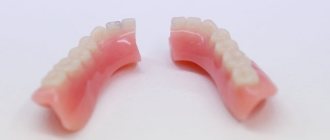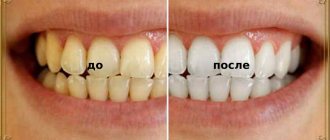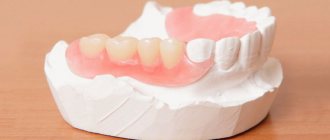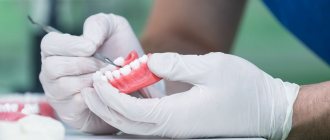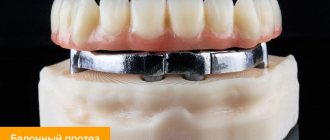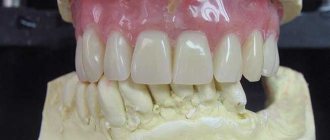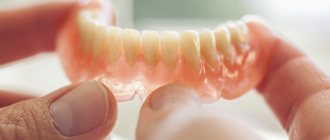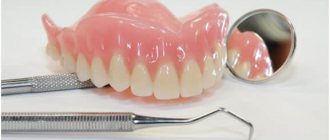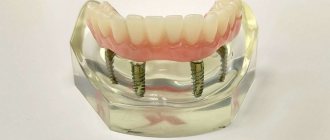Plastic clasp dentures
- one of the varieties of removable clasp structures. They are high-tech orthopedic systems that consist of the following elements:
- arc (clasp);
- plastic base that imitates gums;
- artificial teeth;
- fasteners in the form of hooks, crowns or locks.
Consultation with an orthopedic dentist - 500 rubles.
Clasp prosthesis “Quattrotti” - 55,000 rubles.
At CELT you can get advice from a dental specialist.
- The cost of an orthopedic consultation is 500
Make an appointment
Indications
Plastic dentures
- the best option in cases where the patient is allergic to metal. They can also be used when there are contraindications to installing implants, the main thing is that there are supporting teeth on which fixation can be carried out. Thus, the use of clasp plastic dentures is advisable in the following cases:
- terminal defect of the dentition on one or both sides;
- the need to restore several teeth at once.
Contraindications
- pathological conditions of the oral cavity in the acute stage;
- deep bite;
- insufficiently deep floor of the mouth;
- intensive loss of hard tissues of one or more teeth;
- the frenulum of the tongue is not long enough;
- individual intolerance to plastics;
- lack of supporting teeth;
- patient's mental disorders.
Features of plastic clasp dentures
In the manufacture of conventional clasp dentures, metal is used. If the patient is allergic to this material, plastic dental prostheses
, in which the arc is made of polymer materials (for example, acetal or zirconium oxide). The plastic used for making the frame has high strength characteristics. It combines well with acrylic plastic and allows for relining.
For the production of plastic clasp dentures, Italian equipment “QuattroTi” is used. This is where the slightly modified name of these prostheses “Quadrotti” came from. The technology makes it possible to produce removable clasp dentures with clasps and arches of pink color or the color of tooth enamel.
Polymer materials for removable denture bases
Introduction According to forecasts of the aging population of Western countries, by 2025 more than half of it will be people over 50 years of age.
Despite advances in the prevention of dental disease, it is likely that many of these people will require removable full or partial dentures to replace lost teeth. Currently, about 32 million people in North America wear such dentures, and 9 million complete dentures and 4.5 million partial dentures are manufactured annually for prosthetic patients. It is important for these patients to be provided with aesthetically pleasing and highly functional prosthetics as this will improve their quality of life. Making a removable denture consists of many stages. The first of these is taking an impression, which is followed by a series of technological steps in the dental laboratory. These include obtaining a model, setting the teeth, making a wax model, making a plaster mold in a dental cuvette and removing, boiling, the wax, and then filling the resulting mold space with material for making denture bases or base material. A variety of materials have been used to make prosthetics, including cellulose-based materials, phenol-formaldehyde, vinyl plastics, and hard rubber. However, they all had various disadvantages: Materials based on cellulose derivatives were deformed in the oral cavity, and had a taste of camphor, which was used as a plasticizer. Camphor was released from the denture, causing stains and blisters to form in the base, as well as discoloration of the denture over several months. Phenol-formaldehyde resin (Bakelite) proved to be a very difficult, low-tech material to work with, and it also changed color in the mouth. Vinyl plastics had low strength and fractures were common, possibly due to fatigue of the base material. Ebonite was the first material used for the mass production of prosthetics, but its aesthetic properties were not very good, so it was replaced by acrylic plastics. Acrylic plastic (based on polymethyl methacrylate) is currently one of the widely used base materials, since it has good aesthetic properties, this material is cheap and easy to work with. But acrylic plastic is not an ideal material in all respects, since it does not fully meet the requirements for an ideal material for the base of a denture, presented in Table 3.2.1. But acrylic plastics have become widespread because many of the requirements of Table 3.2.1. they answer. In particular, the technology for manufacturing prostheses from acrylic plastic is quite simple and inexpensive; the prostheses have a good appearance. In addition to its use in complete removable dentures, acrylic plastic is often used for other purposes, such as the manufacture of individual trays for taking impressions, for reproducing the relief of soft tissues on cast metal frames, for repairing dentures, making soft linings for denture bases and artificial teeth. The curing process in the manufacture of acrylic prosthesis occurs through a free radical polymerization reaction to form polymethyl methacrylate (PMMA).
The conversion (transformation) of a monomer into a polymer includes the traditional sequence: activation, initiation, growth and chain termination.
Basic plastics are produced in the form of hot and cold curing materials.
Hot-curing plastics These materials consist of a powder and a liquid, which, after mixing and subsequent heating, turn into a solid state.
The substances included in the powder and liquid are listed in Table 3.2.2. The specific form of application of the material in the form of a powder-liquid system is due to at least three reasons: • The possibility of processing the material in dough form or the use of “dough” technology
• Minimizing polymerization shrinkage
• Reducing the exothermic effect, or reducing the heat of reaction.
The test technology makes the process of making dentures relatively simple.
A dough-like mass is packed into a cuvette containing artificial teeth in plaster, then the cuvette is closed under pressure so that excess mass is squeezed out. The ability of the dough-like mass to accurately adhere to the model and the simple removal of excess make it especially easy to work with cold-curing acrylic plastics (at the test stage) when making special or individual impression trays from them. Granules dissolve more easily in the monomer than balls, thereby reducing the time to achieve a dough-like state of the material. Polymerization shrinkage is reduced compared to monomer polymerization shrinkage because most of the material (ie beads and granules) is already polymerized. The polymerization reaction is highly exothermic because a significant amount of thermal energy (80 kJ/mol) is released when the C=C bonds are converted to -C-C bonds. Since most of the mixture is already in polymer form, the potential for overheating of the material is reduced. Since the maximum polymerization temperature will be lower, the thermal shrinkage of the material will also decrease. Monomer belongs to the category of volatile and flammable substances, so the container with it must be kept closed at all times and away from sources of open flame. The container is a dark glass bottle, which extends the shelf life of the monomer by preventing its spontaneous polymerization under the influence of light. Hydroquinone also extends the shelf life of the monomer by instantly reacting with free radicals that may spontaneously form in the liquid, producing stable free radical compounds that are unable to initiate the polymerization process. Contamination of polymer beads and granules should be avoided because they carry benzoyl peroxide on their surface and only a small amount of polymer is required to initiate the polymerization reaction. The polymer powder is very stable and has an almost unlimited shelf life. A crosslinking agent, such as ethylene glycol dimethacrylate ether, is added to the material to improve mechanical properties (Fig. 3.2.1a). It binds in some places to the polymer chain of polymethyl methacrylate and forms a cross-link between this and the adjacent polymer chain through two terminal double bonds (Fig. 3.2.1 b). Rice. 3.2.1. (a) Ethylene glycol dimethacrylic ether and (b) its cross-linking Thus, although PMMA itself is a thermoplastic plastic, the inclusion of cross-linking agents in the composition eliminates its subsequent heat treatment. Cold Cure Plastics The chemistry of these plastics is identical to that of hot cure plastics, except that curing is initiated by a tertiary amine (such as dimethyl-p-toluidine or sulfonic acid derivatives) rather than by heat. This curing method is less efficient than the hot curing process and produces a polymer with a lower molecular weight. This situation negatively affects the strength properties of the material and also increases the content of residual monomer in it. The color fastness of cold-cured materials is worse than that of hot-cured materials; cold-cured materials are also more prone to yellowing. The polymer balls of these materials are somewhat smaller in size than those of hot-curing plastic (the size of the balls in the latter is about 150 microns) in order to facilitate the dissolution of the polymer in the monomer to form a dough-like mass. This state must be achieved before the curing reaction begins, which will change the viscosity of the mixture, and the mass will acquire excessive density, preventing the material from being molded. Lower molecular weight also results in a lower glass transition temperature (Tg), with Tg typically being 75-80°C, but without increasing the material's tendency to deform. Since no external heat source is used to cure the plastic, the amount of internal stress generated in it is lower. However, the material is very susceptible to creep, and this can significantly affect the appearance of deformations of the prosthesis during use. Cold Cure Pouring Plastics These are cold cure resins that are fluid enough when mixed that they can simply be poured into a hydrocolloid mold. They reproduce surface details well, although their other properties are inferior to cold- and hot-curing moldable acrylic plastics, so they are not widely used. Light-curing base plastics Visible light-curing materials have already been introduced previously.
In terms of their chemical properties, these materials are more similar to composites for dental restoration than to plastics for the manufacture of denture bases. The material consists of a urethane dimethacrylate matrix, which contains a small amount of colloidal silica to give the material the required fluidity or consistency, and a filler of acrylic beads, which become part of an interpenetrating polymer network structure when it cures. It is widely used as a solid material for denture relining, for making custom impression trays, and for repairing broken dentures. Fundamentals of Dental Materials Science Richard van Noort
Published by Konstantin Mokanov
Clasp dentures “QuattroTi”
Clasp dentures “Quadrotti”
are a patented product of the company of the same name from Italy. Today, they are rightfully considered one of the most functional and beautiful removable dentures, capable of providing the patient with maximum comfort. “QuattroTi” are clasp-type orthopedic structures that have a soft arch-shaped base and artificial teeth. For their manufacture, Dental D plastic is used, which is notable for its characteristics:
- it is quite durable;
- differs in elasticity;
- is hypoallergenic;
- has excellent aesthetic characteristics.
Looking at the photo of Quadrotti clasp dentures, you can easily conclude that they look like natural teeth, and therefore are ideal for those for whom the aesthetic component is important.
Why you should give up plastic dentures
The disadvantages are also quite obvious:
- the material is fragile, crowns for chewing teeth from it quickly wear out, cracks and chips often occur;
- with insufficient care, infection may occur, since the structure of the material is porous and bacteria can accumulate in it;
- allergic reactions to some compounds are possible;
- Over time, dentures lose color and are susceptible to the influence of food and artificial dyes.
Toxic stomatitis when using acrylic dentures
In the latter case, the question arises of how to whiten dentures made of plastic at home. Some experts are very categorical and believe that dentures simply need to be changed, but you can resort to the advice of ordinary people, more loyal experts, folk remedies and try to correct the situation.
Advantages and disadvantages
Clasp dentures “Quadrotti”
receive mostly positive feedback from patients. Their advantages are as follows:
- Excellent quality, which consists of flexibility, reliability and hypoallergenicity. On average, the service life of such structures is seven years;
- Decent aesthetic characteristics due to the absence of metal elements. The selection of a soft base is carried out to match the color of the patient’s oral mucosa, and the remaining parts are transparent and therefore invisible;
- Reliable fixation and ease of use are made possible due to the fact that the design does not rub the gums, ensures an even load and eliminates speech disorders.
Whitening in the dentist's office
If all of the above remedies do not bring the desired result, then the denture can be taken to the dentist, where a specialist will perform professional cleaning. The procedure does not last long and takes a couple of hours, meaning you can pick up your prosthesis on the same day.
In addition to cleaning the artificial teeth, the dentist will carefully polish them again to eliminate roughness and apply a special substance that creates a protective film. Thanks to it, plaque on the prosthesis will form much more slowly.
Caring for removable teeth is not particularly difficult if done in a timely manner.
When installing dentures, the dentist explains how to care for them and what is the best way to clean them. If you have your dentures professionally cleaned in a specialist’s office several times a year, you won’t have to use improvised methods for whitening. Read also: Whitening with trays
How to care for plastic dentures?
Caring for plastic clasp orthopedic structures is quite simple and will not be a problem for our patients. At the same time, it is worth noting that it requires compliance with a number of recommendations, which are as follows:
- rinsing with clean boiled water after each meal;
- removing the prosthesis at night, cleaning it with a brush and storing it in a special solution;
- avoiding exposure of the prosthesis in the solution to direct sunlight.
These simple rules will help you maintain the functionality and appearance of the prosthesis and extend its use.
Whitening dentures in dentistry
Cleaning plastic dentures using professional methods is an essential element of care. Why? The fact is that even with regular and thorough cleaning of the denture from food debris, it is unrealistic to completely clean the surface at home. But in dental practice, various hardware manipulations are provided for this:
- Ultrasonic cleaning . The structure is exposed to ultrasonic waves under the influence of a special apparatus. They clean even the smallest plaque particles. Carry out this manipulation once every six months. This will ensure the structure's strength and durability.
- Mechanical cleaning . For these purposes, a special brush is used. The method is used in the presence of mineral deposits on the surface of the prosthesis. After the procedure, the doctor polishes the structure using a special paste. Thanks to it, the prosthesis acquires an aesthetic appearance and is indistinguishable from a new one.
